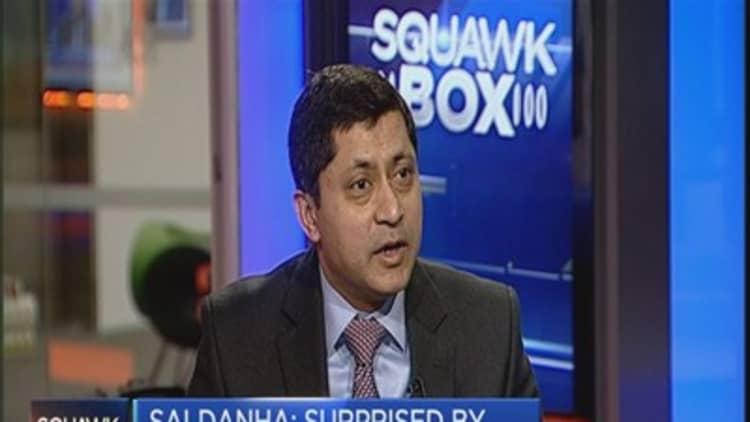The drumbeat for going fossil-free is getting louder among investors worried about climate change. Nearly 200 countries committed to lower carbon emissions at the recent COP21 summit in Paris, and Microsoft billionaire Bill Gates is pouring billions of dollars into a clean energy fund.
The signal for an increasing number of investors is to "green" their portfolios, but there's an even simpler, more pressing reason to be looking at anti–fossil fuel investments. Investors who have tried to time an oil bounce and get in at bottom prices have been burned every time. On Wednesday, oil fell to yet another new low, touching a level it hasn't seen since 2003.
At the same time, fossil fuel–free exchange-traded funds (ETFs) are streaming into the marketplace.
"Climate change is poised to become an economic risk," said Christopher McKnett, head of ESG at State Street Global Advisors. "So more funds are examining high-carbon assets in the form of fossil-fuel reserves."
McKnett adds that more investors divesting from carbon-linked stocks also want to protect their portfolios from the possibility of having stranded carbon assets, a situation in which reserves can't be tapped in the future as governments force companies to leave fossil fuels underground.
But there's another parallel from the divestment movement worth considering for investors tired of trying to time an oil rebound: the fate of coal stocks. Many leading institutional investors have already divested from coal while remaining in other energy stocks. Coal is the worst of the carbon emitters, which led to it being first on the docket of climate investors, but it also happens to be the worst-performing sector in the energy world in recent years, well before oil began to slide, with many companies facing or declaring bankruptcy. The turnaround for coal that some investors hoped for continues to be pushed further off into the future.
The price of oil has roiled energy stocks, and these ETFs are also safer than clean-energy investments, said Neena Mishra, director of ETF research at Zacks Investment Research. "Solar has been very volatile," she said. "And it has crashed. These ETFs are a clean-energy play without some of the risk."
It's not a surprise that OPEC is betting on an oil rebound, but its latest outlook expects that to take more than two decades to occur — with oil returning to $95 by 2040, OPEC predicted in a recent report. For a more optimistic outlook, Statoil recently told CNBC oil prices would rebound — in 2018.
There's already the ProShares S&P 500 Ex-Energy ETF (SPXE), which tracks an index that strips out the energy sector. The fund, which has a 0.27 percent expense ratio, is another way to tap the same anti-oil sentiment. In the past year, this ETF is down 2.5 percent versus an S&P 500 decline of 7 percent, though this year the ex-energy ETF is not outperforming the broader index.
State Street's SPDR S&P 500 Fossil Fuel Free ETF (SPYX) just began trading recently. It tracks an index of companies that don't own oil, gas and coal stocks. "It's a simple fund," McKnett said. "And it's the best fit for core equity holdings."
Top holdings include Apple, Microsoft, GE and Johnson & Johnson. And the net expense ratio is 0.20 percent.
"We're trying to lead a path from today's fossil-fuel dependency," said Doug Sims, a strategy and finance director at the Natural Resource Defense Council's Center for Market Innovation. NRDC is a cornerstone investor in the fund. "It's the mainstreaming of green investing. The linchpin is in carbon reserves," Sims said.

Another new offering, Etho Climate Leadership U.S. (ETHO), is also fossil-fuel free. The diversified fund mirrors an index that studies the greenhouse emissions profiles of more than 5,000 companies and then dubs them climate leaders. It also excludes tobacco, gambling and weapons makers. The fund favors the industrial and technology sectors, and holdings include Netflix and M&T Bank Corp. But the expense ratio, which is 0.75 percent, is relatively high for an index ETF investing in highly liquid U.S. stocks.
"The ETF invests in the most climate-efficient companies in every area," said Ian Monroe, co-founder and chief sustainability officer at Etho Capital. He added, "Climate leaders generally outperform climate laggards, and this trend will accelerate."
Some of the climate change ETFs serve as a low-fee alternative to socially responsible mutual funds avoiding traditional energy stocks, which have also increased in number in recent years and attempt to profit from the same anti–fossil fuel theme.
One issue for investors: As with any new ETF, like Etho (which just launched in November), fund data takes time to be generated, said Todd Rosenbluth, director of ETF and mutual fund research at S&P Capital IQ. Investors will need to wait at least three months to see fund rankings. "Also, new ETFs are small and trade infrequently," he said. "That makes them less efficient as trading vehicles and prone to higher trading costs and bigger swings in performance.
State Street's SPYX ETF launched in December.
Climate leaders generally outperform climate laggards, and this trend will accelerate.Ian Monroeco-founder and chief sustainability officer at Etho Capital
There are some older ETFs with longer track records have targeted low-carbon stocks and doing well attracting investors.
The SPDR MSCI ACWI Low Carbon Target ETF (LOWC) has been raking in assets. The 1,318-stock fund tracks stocks from developed and emerging markets companies with lower carbon footprints than the broader market and has a similar top holdings list to State Street's newer Fossil Fuel Free ETF. Top holdings include Apple, Microsoft and Johnson & Johnson.
The iShares MSCI ACWI Low Carbon Target ETF (CRBN) follows the same index. Both funds also have low 0.20 percent fees.
"These funds have sizable assets," said Mishra. "And you get exposure to well-known companies, like Apple."
But low carbon does not mean no carbon, and the same caution is warranted even for the fossil fuel–free ETFs. For example, low-carbon ETFs own oilfield services companies, including Schlumberger. And the new State Street Fossil Fuel Free ETF includes the same oil service companies, as well as refiners and pipeline companies, though at a total portfolio holdings level that is only 2 percent of assets.
Overall, these ETFs have lots of good, large stocks that have good valuations, Rosenbluth said. But that also means that when the entire stock market is crashing, performance for these ETFs can suffer. Right now the oil rout is pressuring all stocks. The State Street Fossil Fuel Free ETF, for example, is down by 10 percent since its launch last December.
That said, avoiding the energy sector and oil stocks rather than waiting for the bounce may look like a good prospect to more investors who haven't given up on stocks as a whole, and for more reasons than just fighting the long-term effects of climate change.
— By Constance Gustke, special to CNBC.com






